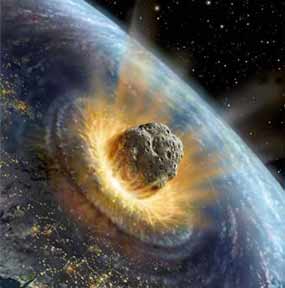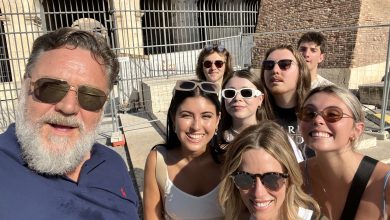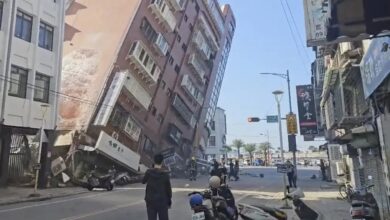
In other space news Star Trek tractor beam is offered to save Planet Earth from asteroid ArmageddonX. The Laser Tractor beam is one of three ways world’s top scientist will save us from possible planet eradicators.
Washington / NationalTurk – A new international consortium of top scientist has been set up to figure out what Earthlings could do if an asteroid came hurtling towards the planet on a path of imminent destruction.
Project NEOShield : Savior of Planet Earth
The project NEOShield focuses on three methods of averting Armegeddon disaster: the Hollywoodesque solution of sending up a team of deep drillers with a powerful nuclear bomb to explode it, or frantically hurling all of our nuke arsenal at it; dragging it to safety with a Star Trek-inspired tractor beam; or hitting it with something we have more control over, like a big spaceship.
The project will explore the possibilities for kinetic impactors, gravity tractors and blast deflection as ways to save our planet from oblivion.
NEOShield focuses on 3 methodes
NEOShield will be led by the German Aerospace Centre (DLR), supported by €4m of European Commission money, and will include research institutes, universities and companies from the UK, France, Spain, Russia and the US as well as Germany.
“There is currently no concerted international plan addressing the impact threat and how to organise, prepare and implement mitigation measures,” a NEOShield initial report reads.
“Protecting the Earth from Near Earth Object (NEO) impacts is a global problem and, as such, any mitigation of damage strategy has to involve at least the most scientifically and technologically capable nations.”
The kinetic impactor idea (slamming into the asteroid with something heavy, like a gigantic spaceship) has already been explored by the European Space Agency in its Don Quijote mission, where it looked at sending a spacecraft to hit the space-rock, but that study didn’t answer every question.
Gravity Tractor is Star Trek tech
“The efficiency of momentum transfer from the impactor ( our spaceship, we will probably name it meotheorf..r ) to the hazardous NEO depends not only on the physical properties of the target… but also on the impact accuracy,” NEOShield stated, adding that it would focus on the guidance, navigation and control of the hit-spacecraft.
The gravity tractor, meanwhile, is strictly theoretical and has only been seen in action on Star Trek series and movies. This is where a spacecraft would affect the asteroid’s intended destructive path by dragging it one way or another using gravitational forces.
There’s obviously lots to be researched out there, new technologies are required including how big the tractor beam has to be, how much power it would take to deflect the NEO, the required distances between the two, how long it would take, and pretty much every other question coming into minds.
Nuke’m all
NEOShield will look finally at the conventional technique of “Hurling all our nukes at it!”, scientifically known as blast deflection, including burying the bomb on asteroid, although it admits that this would only be appropriate in extreme circumstances.
The first problem here will be to stop everyone freaking out when someone fires off a nuke by making sure nuclear response is internationally coordinated.
The scientists will also have to find a way which of the surface or buried blasts would be more effective, and if they did want to bury it, and figure it out if the “current penetrator or drilling technology” would be sufficient to get the job done.
The NEO project is kicking off this week and is will be running for around three-and-a-half years with hopes to lay out the roadmap so we, the citizens of Earth are ready when an actual significant asteroid impact threat arises.
[adrotate banner=”31″]



b.Why is a mission to a Near-Earth Asteroid (NEA) opnirtamt and what would/should the goals of a human mission to a NEA be? Why send humans? Asteroids are a unique source of information about the history of the solar system. The study of asteroids would greatly enhance our knowledge of the initial conditions of the planetary nebula, the formation process of terrestrial planets, the link between meteorite type and asteroid classification and the organics in primitive and evolved materials. Due to an easier accessibility in terms of orbital mechanics, Near Earth Asteroids (NEAs) are the target of choice for such a mission concept. NEAs represent a population similar to the main belt asteroids reflecting the remnant bodies which accreted to form planets. NEA’S are a fascinating population of bodies that are interesting from a variety of perspectives:solar system science, space resources and collisional hazards to Earth.These also act as precursors to Moon or Mars landing missions.Majority of the NEA’s are derived from the main asteroid region as fragments of collisionally broken rock and/or metal parent asteroids.Bodies from this source are more likely to have low-e and low-i orbits and hence be more accessible to the spacecraft. Water is likely to be present in abundance on a significant fraction of these bodies especially the C-class and extinct comet nuclei.These objects are likely to be the only significant sources of between the oceans of Earth and the frozen deposits on Mars and will be a water source that is not in a deep gravity well.With water aboard,these may also act as potential carriers of life across the Universe.A concept that is extensively studied in astrobiology. The mission to the asteroid just needs to collect material, put it in a big bag, and tug it back to Earth. Indeed, it should not be too sophisticated. Apollo 11 basically landed, set foot, dug up some local materials, put it into bags, and came back.If we want to minimize the cost of the mission, we can take a risk and send only enough fuel propellant to return the astronauts and a small sample of material in the case of a mission abort, along with equipment to produce fuel propellants at the asteroid using asteroidal material (equipment which would be discarded in case of mission abort) in case things go as planned. Any fuel propellant we cook out of the asteroid can be used to return additional bulk sample material. Place your bets in stock and legal lotteries now. A solar (or nuclear) oven and simple vapor collection equipment should be sufficient to collect enough fuel propellant from the asteroid for the return trip of a very large collection of asteroidal material. Propellant extraction by heating is very simple technology. (And even if it were not to produce much propellant, the mission would still be profitable.)We could simply break off a chunk of the asteroid by sending a few lightweight handheld explosives, and return this big chunk. Or the astronauts could go with simple shovels and bags to collect big samples from around the asteroid. A variety of simple and lightweight collection means can be sent, and the astronauts can use whatever appears best suited for the task upon their arrival without wasting much weight in unused equipment. The collected sample can be wrapped in a big bag to prevent orbital debris from floating away once it reaches Earth orbit.Once in high Earth orbit, a lightweight inflatable bag can be put around the asteroid to create working space while containing all loose material created by experimenting with various processes.The large increase in expense for a manned mission would be more than offset by the increase in value. First of all, a manned mission would be able to accomplish far more we just don’t have the robotics technology that can replace humans, in terms of adaptability and versatility. Secondly, a manned mission would bring in far more money by product endorsements and media footage. Using Russian manned space program hardware and labor like the Soyuz, Salyut and their derivatives, it would seem significantly more economical and feasible in the relative near-term than using American manned mission capability which has priced itself far out of the market in this two-entity market. Another option is to boost a Mir module to the asteroid. People spend a lot of time going around in circles in Earth orbit. Why not spend that time in transit to an asteroid rather than just going nowhere around Earth?There is also no substitute for man over tele-robot when it comes to communications for prospecting an asteroid up to several light-minutes away, and dealing with the material in hand.While manned missions are risky, computers and unmanned missions are even riskier. Look at the failures of Phobos 1 and Phobos 2, as well as Clementine 1. Put a man in the loop on-site and things would have been engineered and happened differently. Look at all the limitations of the Pathfinder rover on Mars, plus the software bugs that dogged it.Nothing comes close to the human mind for adaptability, flexibility and creativity, at this point in time and in fact for the next 20 years. A manned mission now is justified. If we’re going to be successful, we need to do it right. Forget the penny pinching robotics bean-counters who think small is beautiful , we need to look at making more money and bigger is better . The human value of a media event can give us the necessary money to support a manned mission plus give us extra money to reinvest.With a couple of men, we could bring back one hell of a payload to high Earth orbit and probably do some in-situ processing for oxygen, water and propellants which could extend their stay and help bring back huge samples for industry to play with in orbit.